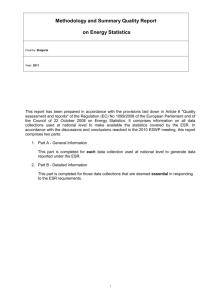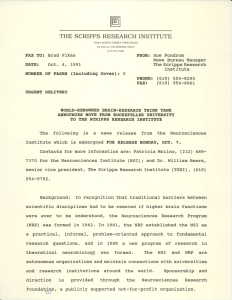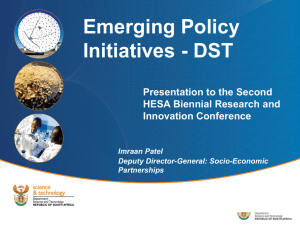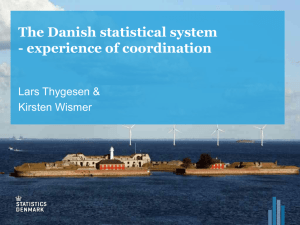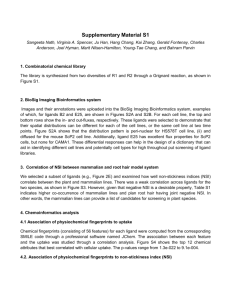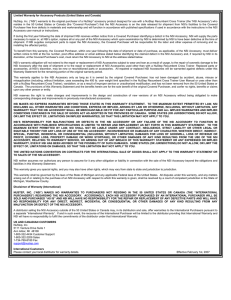Bulgarian experience in the use of administrative data sources for
advertisement
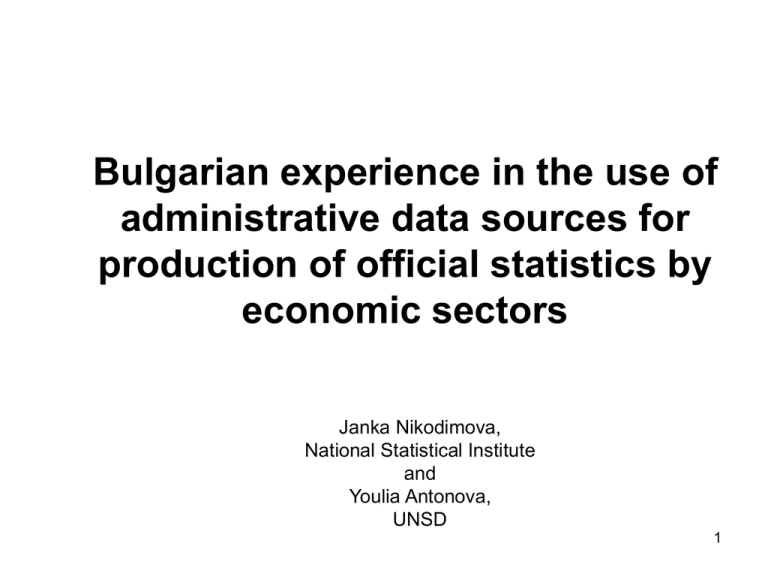
Bulgarian experience in the use of administrative data sources for production of official statistics by economic sectors Janka Nikodimova, National Statistical Institute and Youlia Antonova, UNSD 1 Overview of the administrative data sources and economic statistics • Needs for the use of administrative information – – – – Government policy on reduction of respondents burden Reduction of costs of statistics Growing demands for detailed statistical data Harmonization of Bulgarian Statistical System with the requirements of the EU • Prerequisites for the use of administrative data for economic statistics – Law on Statistics – Existence of a System of unique identification numbers for economic units – Co-operation between statistical offices and other administrative authorities 2 The Law on Statistics • Gives powers to the Bulgarian Bodies of Statistics for “the realization of statistical activity by, registers and information systems they maintain as well as data exchange between them” – Bodies of statistics includes the NSI and the respective structural units within the Ministries, institutions and other bodies of the central and local administration that carry out statistical activity • Provides the legal framework for statistical use of administrative data • Makes provisions for the right of access to administrative data – Bodies of Statistics have the right, upon written request and free of charge, to obtain from other State bodies and holders of register data collected by them which are required in the statistical surveys included in the National Programme for Statistical Surveys – The provision of administrative data is organized on the basis of formal agreements between the NSI and each of the state bodies 3 The Task Force • 2003 – A Task Force group was created to undertake a comprehensive investigation of the existing administrative data sources in Bulgaria – Main objectives of the TF • To identify the existing administrative data sources • To create a list with their names, responsible institution, type of information collected etc. • To find out to what extent the administrative information have been utilized by the NSI departments for the production of official statistics 4 The Task Force (cont.) • 2005 – Update of the existing registers and information systems in state administration • 200 new registers were set up for the period 2003-2005 – Follow up review of the use of administrative data sources by the NSI departments • Objectives – Assessing the progress in the use of administrative information since 2003 – Assessing how individual departments in NSI overcame the challenges of using new information • Organization – On the basis of a short questionnaire sent to all department heads within the NSI – A new department “Data from administrative sources” within the NSI was established • Tasks – To monitor the developments in the national registers system – To maintain a copy of the data from the main administrative registers used for statistical purposes – To deliver, process and store the data from multipurpose sources 5 Review of the use of administrative data sources for statistical purposes • Carried out on the basis of a short questionnaire • The questionnaire asked about the following characteristics of each administrative data source: – – – – Name Content of the data Institution/organization administering the data source Basis for having access to the information in the administrative data source – Frequency of the provided information – Delay after the deadline for submission of data 6 Review of the use of administrative data sources for statistical purposes (cont.) – – – – – – – – Dissemination format Method of delivering the information Stability of the administrative data source Statistical surveys in which administrative information is used How the administrative information is being used Problems (difficulties) faced while using the administrative information Views about the future use of the administrative data source Suggestions for changes in the administrative data source 7 Use of administrative data sources by economic sectors 8 Macroeconomic statistics • National accounts – Sources – Central Bank, Ministry of Finance, National Revenue Agency – Advantages – full access to the MF database, detailed information – Problems – data confidentiality • International Trade Statistics – Sources – Customs Agency – Advantages – the information is used as a frame for statistical surveys and directly – Problems – data confidentiality; diminishing importance of this data source with the membership of Bulgaria to the EU (INTRASTAT system) 9 Macroeconomic statistics (cont.) • Financial Statistics – Sources – Central Bank, Ministry of Finance, National Social Security Institute, Financial Supervision Commission – Advantages – these data sources provide nearly census coverage – Problems – the last data source is very dynamic, provided information is dependent on the legislation changes and harmonization with the EU regulations • Labour Statistics – Sources – National Social Security Institute (Register of Insured Persons), National Employment Agency – Advantages – supplement the information from statistical surveys, update the Statistical Business Register 10 Business statistics • Registers – Statistical Business Register (SBR) • Law on statistics - legal basis for the establishment and maintenance of a SBR • SBR is based on: – Administrative “BULSTAT” register – Statistical surveys • Unique Identification Number (UIN) – Register of Insured Persons, maintained by the National Social Security Institute • Identification of statistical units (enterprises and local units) • Update of data on employed persons 11 Business statistics (cont.) • Statistics of Enterprises – Sources – Annual income tax declarations of single bookkeeping units provided by the General Tax Directorate of Ministry of Finance; employment data from the National Social Security Institute for the same units – Advantages – tax data are used directly for the estimation of output/VA of the units; data are cross-checked with employment information – Problems – the statisticians find it extremely difficult to bind the relevant information from the two data sources and to identify properly those units • Despite the existing UIN the definition of units is incompatible • Incorrectly filled identity numbers in the tax or social security declarations 12 Regional and Multi-Domain Statistics • Agricultural statistics – Ministry of Agriculture and Forestry (MAF) – responsible for current and structural agricultural statistics – NSI – responsible for the Economic Accounts for Agriculture (EAA) • Sources – A large number of different registers in the area of agriculture and forestry, as they exist and are maintained by the agencies of MAF, incl. the Register of Agricultural Farms • Advantages – NSI has direct access to or receives the administrative data; the information provides exhaustive coverage of units • Problems – data for EAA are census type data, referring to a particular point of time, their continuous update is necessary 13 Regional and Multi-Domain Statistics (cont.) • Environment Statistics – National and international requirements for presenting exhaustive environmental data • Sources – Executive Environmental Agency of the Ministry of Environment and Water; Executive Hydro Melioration Agency • Problems – delays in data delivery; change in coverage of data items; extremely unsatisfactory quality and coverage of water supply data – NSI considers discontinuing the use of water supply data from Executive Hydro Melioration Agency and conducting an ad-hoc survey of water supply firms 14 Demographic and Social Statistics • Consumer Price Index and Purchasing Power Parities – Sources – Ministry of Economy and Energy, State Energy and Water Regulatory Commission, data from the Enterprise Resource Planning Systems of some companies – Advantages – cooperation with these companies is considered to be very positive; multipurpose use of data received • Population Statistics Department – Sources – National Register ESGRAON of the General Directorate “Civil Registration and Administrative Services" (CRAS) to the Ministry of Regional Development and Public Works; Ministry of Interior – Problems – confidentiality of data 15 Demographic and Social Statistics (cont.) • Health Statistics – Sources – National Health Insurance Fund; National Centre for Health Information – Advantages – full implementation of the Fund information system, will allow NSI to have access to the basic data of health establishments – Problems – aggregated form of provided information so far • Education Statistics – Sources – Register of the Licensed Centers for Vocational Education; Register of Secondary Education – Advantages – NSI has been granted with full access to the registers information 16 Conclusions 17 General • The access to the administrative information for statistical purposes is provided on the basis of signed formal bilateral agreements between NSI and other institutions, custodians of administrative databases – The agreements specify the terms of provision of administrative information as well as the deadlines • Some departments have well established practice of efficient use of administrative information 18 General (cont.) • The most significant for NSI registers and administrative information systems are utilized for the purposes of either economic or social statistics, especially those having multi domain significance • In their vast majority the administrative data sources are used predominantly as a sampling frame for statistical surveys • The electronic way (CD or e-mail) is the main method of delivering the administrative information 19 Problems • Only a limited number of the existing 400 administrative data sources/registers is being used directly as a source for production of statistical data • Not all statistical departments have fully investigated the potential of administrative data • Some cases of delayed data delivery have been observed • Some authorities provide very aggregated information, which may hamper the compilation of official statistics at detailed activity or regional level • The quality of some administrative data sources does not satisfy fully the statistical criteria 20 Future developments • NSI expects to get further benefits from the use of administrative data over the next few years as their full potential will be exploited – In business statistics - the administrative information will be directly used for production of data for particular groups of units (below certain threshold) – In social statistics – the statistical application of administrative data will be enhanced mainly in the area of education and social protection • NSI is working to find the legal mechanism to impact on the form and content of administrative sources in ways making these more useful for statistical purposes 21 Thank you 22


